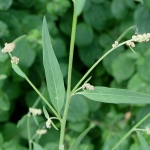| Common Name: |
Orach |
| Other Names: |
Moutain Spinach |
| Botanical Name: |
Atriplex hortensis |
| Genus: |
Atriplex |
| Family: |
Chenopodiaceae |
| Native Location: |
Asia, widely naturalized in Europe and N America. |
| Cultivation: |
Well-drained soil in sun; grows well in coastal locations. |
| Propagation: |
By seed sown in autumn. A. hortensis and A. h. 'Rubra' self-seed freely. |
| Harvest: |
Leaves are picked as required and used fresh. |
| Height: |
60cm-1.2m (2-4ft) |
| Width: |
15-30cm (6-12in) |
| Variations: |
Crimson Plume
Has red-purple leaves that retain color when cooked.
Purple Savoyed
Has thick, puckered, purple leaves.
'Rubra'
(Red orach, red mountain spinach)
Has beet-red foliage and flowers, and comes true from seed.
'Ruby'
Has vivid deep purple leaves and an excellent flavor
Height: 1.2-2m (4-6ft).
'Yellow'
Has pale green-yellow leaves and a good flavor. |
| Hardiness: |
Half hardy |
| Parts Used: |
Leaves |
| Properties: |
A mildly irritant herb that stimulates the metabolism |
| Medicinal Uses: |
Internally to dispel sluggishness. |
| Culinary Uses: |
It may be eaten raw cooked, on its own, or mixed with other vegetables, such as spinach. Traditionally cooked with sorrel to reduce acidity of the latter. Seeds can be eaten. |
| Bibliography: |
Encyclopedia of Herbs by Deni Brown Copyright © 1995, 2001 Dorling Kindersley Limited. pp 137-138 |

